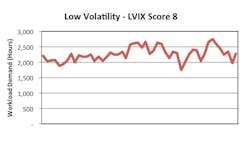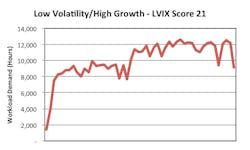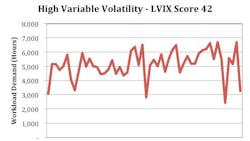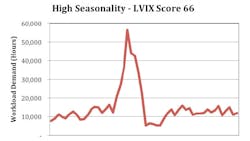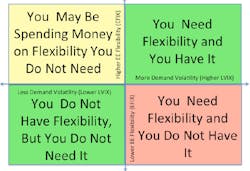Volatility rarely impacted individuals in the past because volatility challenges were handled with high levels of inventory. This allowed employee schedules to remain relatively flat while inventory took the brunt of volatile demand swings.
However, in recent years employees have struggled to an increasing degree with their schedules, driven primarily by last minute changes and inventory levels so low, they no longer cushion the changes in demand. These changes could be a last minute request for overtime, a change in departments or a combination of these or other issues.
Regardless of the cause, employees have been adversely affected due to implementation of lean manufacturing practices without the implementation of complementary scheduling strategies to match the business needs.
The Rise of Labor Volatility
Volatility in the marketplace is not new, but has grown significantly as customer’s expectations have shifted toward the need for immediate gratification. Volatile labor demand, often driven by volatile product demand, is a relatively new concept and understanding it will allow an organization to drive down excess costs. The concept of employees working flexible schedules to meet the ever-changing needs of the customer has only become mainstream in the last few decades and is not well understood and often poorly implemented.
Understanding and properly managing volatile labor demand will allow a company to drive large costs out of the organization, while increasing overall employee satisfaction with both the job and the schedule.—John Frehse and Robert Henley
A critical element to any improvement strategy is to shift the hourly employees to a flexible schedule that not only works for the business, but will also be attractive and sustainable over the long term for employees. Understanding and properly managing volatile labor demand will allow a company to drive large costs out of the organization, while increasing overall employee satisfaction with both the job and the schedule.
All Other Options Have Been Exhausted
Traditionally, the first target for lean operational strategies is the high carrying cost of finished goods. The reduction of these finished goods and subsequent shift to “just in time” delivery has successfully driven down the costs associated with high inventory, without sacrificing customer lead times. However, the natural, yet unintended, consequence is an increase in labor costs due to rigid scheduling practices, premium time pay, efficiency loss and idle time. Companies lacked, and most still lack, the ability to transition their workforce to a flexible alternative shift schedule that does not follow the traditional 120-hour or 168-hour workweek.
In addition to lean inventory practices, historical cost pressures have already removed much of the waste from other areas of the business landscape. Few areas of improvement exist outside of labor strategies. They remain the last true bastion a company can restructure to increase production capacity, reduce cost and, over time, increase morale. While the long-term effects are positive, it must be noted that employee schedule changes are emotional and potentially disruptive. For this reason, they have often been ignored until management teams find themselves on a “burning platform” and with no other alternative. However, procrastination of the inevitable has a punitive effect on morale and can create an adversarial relationship between management and shift workers. For these reasons it is critical for a company to be proactive (rather than reactive) and quantify demand volatility to fully understand the cost implications of the current strategy while exploring new lower cost strategies.
Management teams are often rated on how well they match the employees to this very challenging workload. All workloads are different and without a proper measure of the degree of difficulty of the task, proficient managers may look like they do not know how to do their job. An index has been created to quantify this challenge.
What is the Labor Volatility Index and What Does it Teach Us?
The Labor Volatility Index (LVIX) is a scale of measurement to quantify overall volatility of an organization’s workload on an intraday basis. The Labor Volatility calculation itself is a combination of several equations that take into account deviation from the mean, SKU mix, overall absenteeism, seasonal demand fluctuations and planned or unplanned downtime.
The resulting “score” from the labor volatility calculation will allow a company to rank itself on a scale of volatility. Facilities with lower volatility will want to ensure that they do not incur excess labor costs for unnecessary flexibility. Similarly, facilities with very high volatility will want to look at options that increase their flexibility while reducing the excess labor costs incurred. The LVIX is a calculation that encompasses all the driving forces creating labor demand volatility. Although customer demand is the major driver, other forces are also at work. Some of the factors included in the equation are (but are not limited to):
- Seasonal Customer Demand Fluctuations
- Variable Customer Demand Fluctuations
- Employee Attendance Issues (Both Planned and Unplanned)
- SKU Mix
- Maintenance Downtime
- Supply Shortages
Different variables are weighted based on their direct impact on labor. Both the frequency and degree of volatility impact the LVIX score. The higher the score, the more likely labor is struggling to meet the business requirements. This also drives the need for advanced labor strategies and technologies to manage this volatility. The following charts outline four potential volatility situations that may arise with the volatility calculation. Notice the scaling in the “Y” axis as a reference point for the size of the demand change.
The high volatility chart shown above is categorized as high volatility because of the large spike in workload demand occurring for 5-8 periods in the midpoint of the chart. Facilities experiencing high seasonality will need to find labor strategies that allow for high-density flexibility during the busiest part of the year.
The Equation
The most significant variable in the equation is the ratio of the standard deviation to the mean. This helps quantify the amount of change in demand at a macro level. The frequency of these fluctuations and degree of deviation are combined to be the largest drivers. However, this will successfully show magnitude but will not capture the total story. Other factors such as growth and shutdown periods need to be factored in or out depending on their impact to volatility.
Gauging Your Ability To Handle the Volatility – The Employee Flexibility Index (EFIX)
Employee flexibility is critical to handle workloads with a high level of volatility. There are three main types of flexibility. Establishing which type a business needs is a cornerstone to selecting the right labor strategies.
The three main types of flexibility are: vertical, horizontal and density flexibility.
- Vertical flexibility is the need for short-term intraday increases or decreases in labor capacity. This can be achieved by adding hours to the beginning or end of an employees shift (e.g. An example would be an 8-hour evening shift employee staying for 10 hours).
- Horizontal flexibility is when additional production is needed outside of the normal operating period. Extending a 5-day work, Monday to Friday operation week to Saturday or even Sunday on premium time is an example of creating or possessing horizontal flexibility.
- Density flexibility is the ability to add or remove staff within the current daily headcount to increase or decrease production rates without increasing or decreasing the operating hours of a facility.
There are many areas of labor strategy that limit flexibility. However, the following list comprises some of the largest limiting elements of labor flexibility:
- Low or no overtime
- 8-hour shift schedules
- No part time or temporary employees
- You operate 24 hours/day 5 days/week
- You do not have schedules that easily flex based on seasonal or variable demand
- Lack of cross training
- The inventory strategy was created in a vacuum and does not take into account adverse labor costs
- No workforce management technology (Including scheduling, activity management and analytics)
- Ineffective integration of maintenance and operations
- Overstaffing to handle peak volume and/or vacations and holidays
Overtime
Limiting overtime to less than 5% is a long held belief for how to control a company’s variable costs. In reality, this level of overtime utilization can mean that a company is instead filling the hours with full-time employees. Once burdened with all the cash and non-cash benefits, straight time is, in many cases, more expensive than overtime. Provided employees are interested in working between 10-20% overtime on a continued or alternating week basis, it can be a great tool for companies to flex up in a financially responsible way.
8-Hour Shifts
The 8-hour shift has been the longstanding go-to shift length for many decades. They fit nicely into a 5-day workweek and three shifts provide 24-hour coverage. The increasingly significant problem is that companies are working 6 and 7 days each week and with 8 hour shifts employees are getting few full weekends off and may not be getting many days off either. These 8-hour shifts are generally not flexible and as businesses grow they have a hard time letting go of past practices. Businesses often wait until they are on a seemingly burning platform before they properly engage the workforce and find relevant solutions.
Some require a fresh look at long held beliefs that are no longer valid, while others require a transformation of the workforce’s mindset. There are no quick or easy fixes to create flexibility with the workforce. Companies with a correspondingly high LVIX should be looking at making these types of adjustments.
So Where Do You Fall?
Understanding the Labor Volatility Index score is the first step in this process. How dynamic is the workload curve and how difficult is it to match the workforce to it? Once the LVIX score is identified, it is time to take a detailed look at the flexibility of the workforce. Do the needs of the business match the flexibility of the workforce?
Employee Tolerance and Preferences
In order to take maximize efficiency and savings the company must first understand three basic components: 1) What type and quantity of volatility the facility is experiencing, 2) The LVIX rating and what it implies from a solutions perspective, and 3) What the employee tolerances are with regard to weekly hours and change overall.
Properly positioning a facility is a long-term process that evolves as the product demand evolves. The labor volatility curves can change drastically year over year and so companies must be cognizant that the appropriate solutions work not just today but also five years from now. To achieve this end, several factors must be taken into consideration when looking at workload demand:
- Does the facility have short-term bursts in demand that cause your labor requirements to spike rapidly and then fall?
- Does the facility have long upswings followed by slow downturns?
- Is the demand seasonal such that a scheduler can predict these swings?
- Is it variable so the scheduler has to reschedule on the fly when swings occur?
There are many forces at work when determining labor volatility. It can be correlated directly to the customer demand curve, heavily dependent on SKU mix, or some combination of the two pieces. When employees scramble to flex up and down based on the ever-changing landscape of demand, they are often ill-equipped – still utilizing traditional shift schedules in a less than traditional demand environment. Employees are most often working in siloes without the proper skills as the workload shifts from area to area inside the operation. Add the fact that many are working too many hours while others feel they are not working enough. This behavior is a key driver of absenteeism and quality. In the worst cases, the work is simply not getting done and customers are finding other, more reliable suppliers.
In today’s “on demand” world, consumers and businesses expect immediate results. Regardless of industry, brand or otherwise, customers expect companies to respond immediately. The ability to react rapidly to changes in demand is one of the most crucial capabilities in business today. Historically staffing additional employees or carrying extra inventory would have solved the problem. With the current business environment these options are too expensive. Every wasted dollar decreases a company’s competitive advantage. Whatever the industry, to remain competitive, companies must respond quickly to fluctuations in demand while minimizing costs. The proper labor strategies, customized for each company’s unique demands, will provide the flexibility to meet volumetric volatility efficiently, without putting undue burdens on the shift worker.
John Frehse is managing partner and Robert Henley is vice president, Quantitative Analytics for Core Practice LLC, a New York-based consulting firm that designs and implements labor strategies for shift work operations

